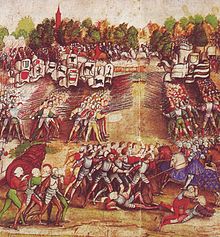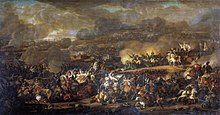Sparta
The Spartan Army was one of the earliest known professional armies. Boys were sent to a barracks at the age of seven to train for being a soldier. At the age of thirty they were released from the barracks and allowed to marry and have a family. After that, men devoted their lives to war until their retirement at the age of 60. Unlike other civilizations, whose armies had to disband during the planting and harvest seasons, the Spartan serfs or helots, did the manual labor.
This allowed the Spartans to field a full-time army with a campaign season that lasted all year. The Spartan Army was largely composed of hoplites, equipped with arms and armor nearly identical to each other. Each hoplite bore the Spartan emblem and a scarlet uniform. The main pieces of this armor were a round shield, a spear and a helmet.
Ancient Rome

The Roman Army had its origins in the citizen army of the Republic, which was staffed by citizens serving mandatory duty for Rome. Reforms around 115 BC turned the army into a professional organization which was still largely filled by citizens but citizens who served continuously for 25 years before being discharged.
The Romans were also noted for making use of auxiliary troops, non-Romans who served with the legions and filled roles that the traditional Roman military could not fill effectively, such as light skirmish troops and heavy cavalry. After their service in the army they were made citizens of Rome and then their children were citizens also. They were also given land and money to settle in Rome. In the Late Roman Empire, these auxiliary troops, along with foreign mercenaries, became the core of the Roman Army; moreover, by the time of the Late Roman Empire tribes such as the Visigoths were paid to serve as mercenaries.
Medieval Europe

In the earliest Middle Ages it was the obligation of every noble to respond to the call to battle with his own equipment, archers, and infantry. This decentralized system was necessary due to the social order of the time, but could lead to motley forces with variable training, equipment and abilities. The more resources the noble had access to the better his troops would be.
The knights were drawn to battle by feudal and social obligation, and also by the prospect of profit and advancement. Those who performed well were likely to increase their landholdings and advance in the social hierarchy. The prospect of significant income from pillage, and ransoming prisoners was also important. For the mounted knight war could be a relatively low risk affair.
As central governments grew in power, a return to the citizen armies of the classical period also began, as central levies of the peasantry began to be the central recruiting tool. England was one of the most centralized states in the Middle Ages, and the armies that fought in the Hundred Years' War were, predominantly, composed of paid professionals.
In theory, every Englishman had an obligation to serve for forty days. Forty days was not long enough for a campaign, especially one on the continent.
Thus the scutage was introduced, whereby most Englishmen paid to escape their service and this money was used to create a permanent army. However, almost all high medieval armies in Europe were composed of a great deal of paid core troops, and there was a large mercenary market in Europe from at least the early 12th century.
As the Middle Ages progressed in Italy, Italian cities began to rely mostly on mercenaries to do their fighting rather than the militias that had dominated the early and high medieval period in this region. These would be groups of career soldiers who would be paid a set rate. Mercenaries tended to be effective soldiers, especially in combination with standing forces, but in Italy they came to dominate the armies of the city states. This made them considerably less reliable than a standing army. Mercenary-on-mercenary warfare in Italy also led to relatively bloodless campaigns which relied as much on maneuver as on battles.
Early modern

First nation-states lacked the funds needed to maintain standing forces, so they tended to hire mercenaries to serve in their armies during wartime. Such mercenaries typically formed at the ends of periods of conflict, when men-at-arms were no longer needed by their respective governments.
The veteran soldiers thus looked for other forms of employment, often becoming mercenaries. Free Companies would often specialize in forms of combat that required longer periods of training that was not available in the form of a mobilized militia.
As late as the 1650s, most troops were mercenaries. However, after the 17th century, most states invested in better disciplined and more politically reliable permanent troops. For a time mercenaries became important as trainers and administrators, but soon these tasks were also taken by the state. The massive size of these armies required a large supporting force of administrators.
The newly centralized states were forced to set up vast organized bureaucracies to manage these armies, which some historians argue is the basis of the modern bureaucratic state. The combination of increased taxes and increased centralisation of government functions caused a series of revolts across Europe such as the Fronde in France and the English Civil War.
In many countries, the resolution of this conflict was the rise of absolute monarchy. Only in England and the Netherlands did representative government evolve as an alternative. From the late 17th century, states learned how to finance wars through long term low interest loans from national banking institutions. The first state to master this process was the Dutch Republic. This transformation in the armies of Europe had great social impact. The defense of the state now rested on the commoners, not on the aristocrats.
However, aristocrats continued to monopolise the officer corps of almost all early modern armies, including their high command. Moreover, popular revolts almost always failed unless they had the support and patronage of the noble or gentry classes. The new armies, because of their vast expense, were also dependent on taxation and the commercial classes who also began to demand a greater role in society. The great commercial powers of the Dutch and English matched much larger states in military might.
As any man could be quickly trained in the use of a musket, it became far easier to form massive armies. The inaccuracy of the weapons necessitated large groups of massed soldiers. This led to a rapid swelling of the size of armies. For the first time huge masses of the population could enter combat, rather than just the highly skilled professionals.

It has been argued that the drawing of men from across the nation into an organized corps helped breed national unity and patriotism, and during this period the modern notion of the nation state was born. However, this would only become apparent after the French Revolutionary Wars. At this time, the levée en masse and conscription would become the defining paradigm of modern warfare.
Before then, however, most national armies were in fact composed of many nationalities. In Spain, armies were recruited from all the Spanish European territories including Spain, Italy, Wallonia (Walloon Guards) and Germany. The French recruited some soldiers from Germany, Switzerland as well as from Piedmont. Britain recruited Hessian and Hanovrian troops until the late 18th century. Irish Catholics made careers for themselves in the armies of many Catholic European states.
Prior to the English Civil War in England, the monarch maintained a personal Bodyguard of Yeomen of the Guard and the Honourable Corps of Gentlemen at Arms or 'gentlemen pensioners', and a few locally raised companies to garrison important places such as Berwick on Tweed or Portsmouth (or Calais before it was recaptured by France in 1558).
Troops for foreign expeditions were raised upon an ad-hoc basis. Noblemen and professional regular soldiers were commissioned by the monarch to supply troops, raising their quotas by indenture from a variety of sources. On January 26, 1661 Charles II issued the Royal Warrant that created the genesis of what would become the British Army, although the Scottish and English Armies would remain two separate organizations until the unification of England and Scotland in 1707. The small force was represented by only a few regiments.
After the American Revolutionary War the Continental Army was quickly disbanded as part of the Americans' distrust of standing armies, and irregular state militias became the sole ground army of the United States, with the exception of one battery of artillery guarding West Point's arsenal. However, because of continuing conflict with Native Americans, it was soon realized that it was necessary to field a trained standing army. The first of these, the Legion of the United States, was established in 1791.
Until 130 the common soldiers of Prussian Army consisted largely of peasantry recruited or impressed from Brandenburg-Prussia, leading many to flee to neighboring countries. In order to halt this trend, Frederick William I divided Prussia into regimental cantons. Every youth was required to serve as a soldier in these recruitment districts for three months each year; this met agrarian needs and added extra troops to bolster the regular ranks.

Russian tsars before Peter I of Russia maintained professional hereditary musketeer corps (streltsy in Russian) that were highly unreliable and undisciplined. In times of war the armed forces were augmented by peasants. Peter I introduced a modern regular army built on German model, but with a new aspect: officers not necessarily from nobility, as talented commoners were given promotions that eventually included a noble title at the attainment of an officer's rank. Conscription of peasants and townspeople was based on quota system, per settlement. Initially it was based on the number of households, later it was based on the population numbers.
The term of service in the 18th century was for life. In 1793 it was reduced to 25 years. In 1834 it was reduced to 20 years plus 5 years in reserve and in 1855 to 12 years plus 3 years of reserve.
The first Ottoman standing army were Janissaries. They replaced forces that mostly comprised tribal warriors (ghazis) whose loyalty and morale could not always be trusted.The first Janissary units were formed from prisoners of war and slaves, probably as a result of the sultan taking his traditional one-fifth share of his army's booty in kind rather than cash.
From the 1380s onwards, their ranks were filled under the devşirme system, where feudal dues were paid by service to the sultan. The "recruits" were mostly Christian youths, reminiscent of Mamelukes.
China organized the Manchu people into the Eight Banner system in the early 17th century. Defected Ming armies formed the Green Standard Army. These troops enlisted voluntarily and for long terms of service.
Late Modern

Conscription allowed the French Republic to form the La Grande Armée, what Napoleon Bonaparte called "the nation in arms", which successfully battled European professional armies.
Conscription, particularly when the conscripts are being sent to foreign wars that do not directly affect the security of the nation, has historically been highly politically contentious in democracies.
Canada also had a political dispute over conscription during World War II. Similarly, mass protests against conscription to fight the Vietnam War occurred in several countries in the late 1960s.
In developed nations, the increasing emphasis on technological firepower and better-trained fighting forces, the sheer unlikelihood of a conventional military assault on most developed nations, as well as memories of the contentiousness of the Vietnam War experience, make mass conscription unlikely in the foreseeable future.
Russia, as well as many other nations, retains mainly a conscript army. There is also a very rare citizen army as used in Switzerland (see Swiss army). |